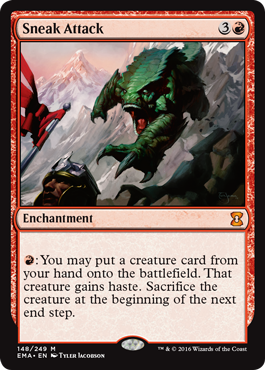Eternal Formats of the Spotless Mind
Welcome to the Eternal Masters preview week. This week, I'll be walking you through the history of the Eternal formats Vintage and Legacy, introducing the Eternal Masters design team, talking about how Eternal Masters was designed, and then showing off a preview card (here's a hint—I designed it! Okay, not the best of hints). If this sounds like fun, read on.
A Long Time Ago
I like to think that, among other things, Making Magic is a Magic history column. Eternal Masters is a product that looks backward, so I think it's important to start today by walking everyone through how exactly Vintage and Legacy, the two highest-profile Eternal formats (I'm putting Commander in a different category even though it technically is an Eternal format), came to be. To understand this, we have to get in our time machine and travel back to the year 1993.
Magic: The Gathering premiered in the summer of 1993. The rulebook did very little to tell you what you could put in your deck. There were no card limitations; you could put as many copies of cards in your deck as you wanted. In fact, the design of
In the early days, Wizards of the Coast wasn't running many tournaments, but others were, and the 40-card deck size and lack of card restrictions proved to be a problem. Quickly, the default was to change the deck size to 60 cards and add a four-card limitation for any one particular card. In early 1994, the Duelist Convocation (it would later add "International" and become the DCI) began, and the 60-card deck size and four-card limitation became part of the tournament rules. It would soon after find its way into the official rules for the game. When Limited started becoming a thing, it was decided that the 40-card deck limit would be used there. (Much of Richard Garfield's early calculations treated casual play similarly to Sealed Deck, as he assumed players wouldn't own too many cards.)
Back in 1994, the idea of formats didn't exist. There weren't different ways to play the game. People were starting to play versions of Sealed, but any type of Constructed event was just Magic. You could play any of the cards available. There was a banned and restricted list, but barring those, any card was fair game. Which brings us to 1995.
Ice Age was about to be released, and R&D had started to realize that there was a problem. You see, Richard had made the assumption that players would spend on Magic what they spend on an average board game. That meant that any one player just wouldn't have that many cards. Yes, they could possibly have one very powerful card, but as they were rare it would be highly unlikely at the estimated numbers that a deck would have more than one or two disruptive cards. The variance of the game and the mix of lower-quality cards that would have to be played would wash out the noise of the overly powerful cards.
The problem was that Richard's assumption turned out to not be true. Players didn't just open a handful of packs. Players were buying boxes of booster packs. That meant that players were able to craft decks out of nothing but the powerful cards. Richard knew it was a possibility but chalked it up to "this only happens if the game is wildly successful and then we'll have to solve it then." Well, it was "then."
The long-term answer was to readjust the average card power. Things like the Power Nine (Alpha's

The idea was that Magic would now have two formats, labeled Type 1 and Type 2. Type 1 would be the status quo. You could play whatever cards you wanted provided you followed the banned and restricted list. Type 2 would limit you to the latest two years' worth of cards. Cards would rotate in and out of this format, as it only covered the most recent two years. When Type 2 was first announced, it was met with great disdain from the players. "What do you mean there's a format where I can't play all my cards?"
In the early days, Type 1 reigned supreme and Type 2 was treated as a novelty. But as time advanced and more and more expansions got released, it became harder for newer players who weren't around for the early sets to get their hands on those cards. So the newer players started gravitating toward Type 2. There were still those who preferred Type 1, and even though Type 2 kept growing in volume, Type 1 had its die-hard fans.
Now, let's fast forward a little. The gap between Type 1 and Type 2 was growing larger each year. There began to be a group of players who wanted a format bigger than Type 2 but one that didn't have the power level of Type 1 (nor would it require accessing what were now some very hard-to-get cards). The solution was a new format called Type 1.5. It was the Type 1 pool of cards except the entire banned and restricted list was banned.
Type 1 would go through a few name changes but would ultimately end up being known as Vintage. Type 2, obviously, became Standard. Type 1.5 went through a change back in 2004, where instead of simply banning Vintage's banned and restricted list, it also got a banned list of its own. There were just cards that, while not problematic in Vintage, were causing issues in Type 1.5. The format would then get renamed Legacy.
Years later, Vintage and Legacy, along with a number of other less-played formats, would get labeled as Eternal formats (meaning they included all Magic cards barring banned and/or restricted ones). When Commander finally became a thing, it got added to the list. So if you're wondering what exactly the name Eternal Masters is referencing, now you know.
Masters of the Eternal
Now that we have the history of the formats out of the way, let's get to the product itself. Eternal Masters is a little different from a normal Magic expansion, but it still has a design team, so I'll introduce them.

Tom LaPille (lead)
It's unusual to see a developer leading a design team, but reprint products are a bit of a different animal when it comes to design. Because the cards already exist, designing a set like Eternal Masters is more about balancing an environment than creating something from scratch. Probably the closest analogy is making a cube, something Tom is well known for and one of the things that helped him land his job in R&D in the first place. This was the last product Tom worked on before leaving Wizards to work elsewhere in the game industry. Tom is missed, but we all have one last Magic set to remember him by.

Ethan Fleischer
Ethan had worked on Vintage Masters (a product exclusive to Magic Online), which was similar in many ways to Eternal Masters. A lot of Ethan's research on Vintage Masters proved invaluable in putting Eternal Masters together. Most of the time, Ethan is designing brand-new cards, so he enjoyed the challenge of making sets by combining old cards. Ethan is very much a historian of the design of the game, so he loves finding old cards that most players have forgotten about and finding ways to work them into sets, a skill well suited for Eternal Masters.

Aaron Forsythe
As Senior Director of Magic R&D, Aaron gets to be the boss, which has plenty of perks. The one big downside, though, is he doesn't get to dive into design and development teams as much as he'd like. He does get to pick and choose the few teams he does join, meaning Eternal Masters was something he very much wanted to design. Like Tom and Ethan, Aaron is also a fan of cards from way back when, and he also had great fun finding hidden gems to include in the product.

Bryan Hawley
Bryan is a developer. One of his major responsibilities is overseeing collation, a very important but difficult and at times mind-numbing task. Bryan is quite good with numbers, and a set like Eternal Masters has a lot more number issues than you might realize at first blush. Bryan was the final member of the four-person design team.
Game, Set, Match
One of the questions I always get about products like Eternal Masters is how designing them is different than designing a normal set. The biggest difference is that you start with all of your potential cards as a known quantity. It's not about what space you want to explore, but what space does your existing card pool allow you to explore? For Eternal Masters, for example, the design team started out with the following question: What cards are we most interested in having in this product? Cards like
The follow-up question was, what are the two-color archetypes we expect to define the Limited environment? This was a bit of a more complicated question to answer. The team started by making suggestions of what themes might be able to be supported, and they were willing to push boundaries more than normal. Remember that supplemental sets have more of a niche audience, so some of the limitations we place on ourselves for normal sets don't apply.
For example, Eternal Masters was aimed at a more advanced player. That meant that we were much less bound by New World Order than a normal set because there was no expectation that this product would be someone's introduction to the game. Also, as the set was trying to create the feel of older formats and had the limitation of having to use older cards, the design team was okay with having more complex archetypes involving more board complexity and higher amounts of card advantage at lower rarities than we see in modern-day sets.
The team explored a wide variety of two-color archetypes. For instance, the white-blue theme for a short time was a Sleight Knight archetype using white cards that referenced color, often protection, with blue cards capable of permanently changing color words (like Alpha's
All of this was done with a few larger goals in mind. First, this was Eternal Masters, meaning it was leaning toward having cards more relevant to older formats. Cards were allowed from Modern-legal sets, but the design team leaned away from powerful Modern cards, leaving those for future Modern Masters sets and instead focusing on cards that either played well in Eternal formats or worked well with the old-school archetypes the draft was built around.
The team did a lot of research about which cards hadn't been reprinted before, especially in newer frames and in premium form. The focus for this set was on making sure that it was chock-full of old-school "goodies" while also creating a fun and nostalgic Limited environment.
One of My Designs
The last thing I need to do is show off my preview card for today. To have a little fun, I thought I'd tell the story of its design and see how many paragraphs it takes for you to figure out what my preview card is.
My preview card's story starts during Tempest design. I'd been on the development team for Visions, and there was a card that I really liked called
It costs three mana for a 4/2 creature with haste that returns to your hand at the end of the turn you play it. (Okay, technically the end of any turn, but you need shenanigans for that to happen.) It just did something cool that intrigued the designer in me. (Interestingly, this card would also lead me to create the dash mechanic many years later.)
So less than a year later, I was leading the design of Tempest and I decided to make a card inspired by
Here's my first version (note I'm updating the wording to roughly modern templating to avoid confusion):
Blitzkrieg (version 1)
1RR
Enchantment
All creature cards cost 2 less to cast. They have haste and return to their owner's hand at the end of the turn.
Note that I cost it at 1RR as a tribute to the card that inspired it. Why did I make it affect all creatures? Because of this card:
I had a blue-green weenie deck that made use of
So I rethought the card. What was I after? What was the fun of the card? I wanted you to be able to cast big creatures before you normally could. I also realized it wasn't about messing up your opponent's plans, so I changed it to just affect your creatures.
Blitzkrieg (version 2)
1RR
Enchantment
All your creature cards cost 3 less to cast. They have haste and return to their owner's hand at the end of the turn.
The new version just changed the mana cost you wanted to focus on (now four instead of three). What I really wanted was a way for you to cast any creature. Also, I wanted you to be able to cast your creature normally if you wanted. I didn't want to force you to only get it for a turn. So instead of casting the creature, I came up with the idea of paying a set amount and just putting it onto the battlefield. To make that work, though, I needed a slightly more serious drawback. I couldn't let you just cast a giant creature turn after turn. That's when I decided to change the bounce effect to a sacrifice.
Blitzkrieg (version 3)
1RR
Enchantment
1R: Put a creature card from your hand onto the battlefield. That creature gains haste. Sacrifice the creature at end of turn.
This version played well, but Tempest had so much stuff crammed into it that it didn't make the final cut. A year later, when I was on the Urza's Saga design team, I resubmitted a slightly tweaked version of Blitzkrieg, changing the mana cost and activation costs slightly. The result was my preview card today.
Have you guessed it yet?
Click here.

Yes, my preview card is
Sneak Attack . A card that went on to become a much-beloved card that many a deck has been built around. You can enjoy it this summer in Eternal Masters.
Eternal Flame
That's all I have for today. Hopefully you enjoyed my peek into Eternal Masters and the history behind Vintage and Legacy, as well as the design of
Join me next week, when I explore what I've learned in the last 20 years.
Until then, may your duels be Eternal.
"Drive to Work #332—Card Elements"
In this podcast, I walk through a Magic card and talk about each element on it.
"Drive to Work #333—Market Research"
I often talk about how we use market research to get a better understanding of what players want. I use this podcast to explore how we do market research.
- Episode 333 Market Research (15.0 MB)
- Episode 332 Card Elements (16.9 MB)
- Episode 331 Storm Scale: Khans of Tarkir (16.1 MB)
- Episode 330 Storm Scale (17.6 MB)
- Episode 329 20 Lessons: Human Nature (17.5 MB)

